I was never any good at Gradius (or any shooter for that matter), but I love them all the same. I saw that the PS4 just got Gradius (the arcade version) as a download. I'm tempted to get it, but I have the Gradius Collection on PSP and Gradius V on PS2 if I ever need a fix. Konami (and Treasure) were the kings of shooters back then.
Gradius Review Rewind
|
|
See PixlBit's Review Policies

On 06/24/2015 at 10:30 AM by Jamie Alston Destroy the core! |

An essential game if you like ‘80s 2D shooters.
The 1980s was a true renaissance period for the budding video game industry. Arcade games like Xevious, Donkey Kong, and OutRun gave us new levels of visual, audio and strategic detail that took us beyond the comparatively simple mechanics of Pong and Space Invaders. It was indeed the golden age of gaming.
One such revolutionary game during this period was Gradius. Originally intended to be a sequel to Scramble, it was developed into a completely separate, well-polished shoot ‘em up in 1985. A year later, Gradius went on to be ported to the NES as one of Konami’s earlier releases for that system. When I got his game as a kid, I knew that in my 10-year-old hands was something more than just a run-of-the-mill video game. No--I was holding destiny in my grasp; and according to the note on the box art, so had over a million others in Japan.
The game is about an earth-like world called Gradius under attack from invaders known as the Bacterians. As an old nemesis of the citizens of this peaceful planet for reasons not to be explained here, these hostile aliens are intent on destroying Gradius. You pilot the advanced inter-dimensional spaceship Vic Viper. Your goal is to battle your way to the Bacterian’s super fortress and kill it. Surely this’ll solve the problem for good.
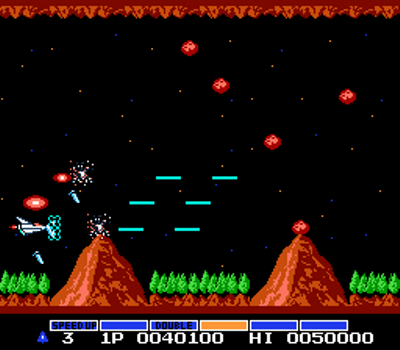
Gradius brought something new yet practical to the shooter genre--an intuitive power-up system. Capsules collected from red colored enemies would advance the cursor one space across the weapon gauge and allow you to select the currently highlighted upgrade. Power-ups include speed (increasing maneuverability), missiles, a double shot, lasers, option drones, and a shield barrier. While you can use multiple upgrades at once, you have to select them one at a time, making it a challenge to stay alive long enough to fully arm your ship.
This added an additional layer of strategy that at times required careful planning for the best results. For instance, while the laser upgrade is definitely the most powerful weapon, there are quite a few occasions where the double shot may serve you better since it can it can hit enemies both in front and above your position as well. So you might find yourself juggling between both weapons and keeping on the lookout for weapon capsules.
The shield is also an invaluable asset because it does a fairly good job at protecting you from everything but a full-on collision and can take a fair number of hits before giving out. As you progress further into the game, you’ll be constantly under heavy fire. I found it prudent to have that shield section of the weapon gauge at the ready so I could replenish my shield in the very likely event it depletes. That need for vigilance made the game all the more fun to play.
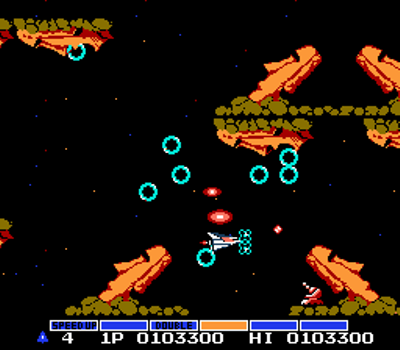
One of the more unique weapons for its time was the option drones. They are best described as miniature satellite “wingmen” that mimic your maneuvers and are outfitted with the same weapon configuration as the Vic-Viper. Best of all, they’re indestructible which allows you to strategically place them in harm’s way without fearing that they’ll be destroyed by a stray bullet or hazard. At full capacity, the options triple your effectiveness in combating the enemy. This was the gameplay element that solidified my enjoyment of Gradius because it provided a decent balance to the enemy onslaught and I felt like I could beat the game if I tried hard enough. In short, I saw the option drones for what they really were--helpers that were actually helpful in the thick of battle.
There is one glaring downside to being fully armed with all these goodies--dying. If you end up clipping a bullet with a shield or crash into something, you'll be stuck with a slow ship and the basic pea shooter upon re-spawning at the checkpoint. Sometimes you'll pick up at a particularly tough section of a level, and if you can't move around quickly, then it’s quite unlikely you’ll make it far enough to properly outfit your ship again. It tends to work against that balance I spoke about in the previous paragraph. However, with a bit of practice and patience, I found myself in those circumstances on fewer occasions and it didn’t ruin the overall enjoyment of the game.
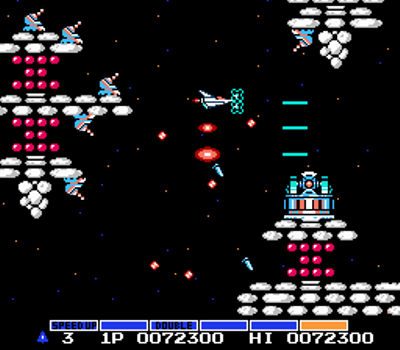
The game’s designer Nakamura Kengo and his team had quite an imagination and put it to good use here. Each stage has its own unique environment, ranging from volcanic and stone ruins to organic alien constructs filled with tentacled creatures and amoeba-like organisms. It was as if you had warped into a different universe each time you progressed to the next area. The behavior of the enemies added to the polished presentation of the game. Besides the obligatory flying enemies, the game also featured walking robotic gun turrets with cannons that adjusted their trajectory according to your position.
Machines bounced along the ground and ceiling to spew a volley of bullets. Hatches of miniature bases opened to release swarms of smaller attack ships. And I’d be remiss if I didn’t mention those awesome ring-spitting Easter Island statues in the 3rd stage. Such enemy designs may have seemed a bit out of place at the time, but they worked well together and contributed to the notion that nothing like this had been tried before.
This is an arcade port done right. While nothing is really missing or changed in terms of overall content, certain gameplay elements from the original were wisely scaled back for the NES version. Most obviously, the graphics were simplified due to hardware limitations. Additionally, you can have only two option drones instead of four; and your laser fires in shorter bursts than in the arcade. The number of enemies and other objects were reduced as well to minimize slowdown and flickering (though the latter is still quite noticeable throughout the game).
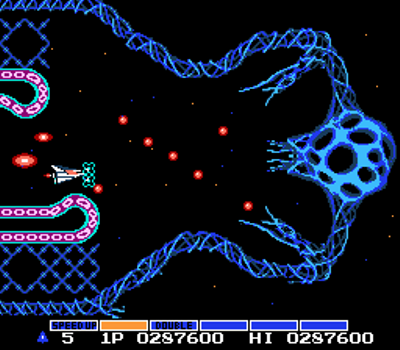
Despite the limitations of the home port, the audio presentation is still faithful to the arcade version. The Gradius series has always been known for its distinctive musical score, and it all started here with this one. Based on the ‘80s pop music scene at the time, Konami’s sound design team pumped out some of the most memorable tunes in gaming history. The fast-paced synth tunes were upbeat in most stages and supplemented that feeling of wonder and excitement as you blasted your way through hordes of adversaries. It’s the kind of soundtrack that many enjoy listing to even when they aren’t playing the game. It really speaks well of the work that was put into the design of the game.
Gradius is a solid game that makes few mistakes in execution. It’s a deceptively simple shooter that introduced layers of strategy that pushed the genre beyond previously conceived notions. While dying is always a bummer since it leaves you severely underpowered for the next section of the stage, it isn’t enough to detract from the overall satisfaction. It’s a must-play for 2D shooter fans, and a personal love of mine that spans the entire series.







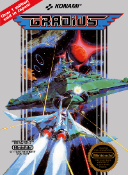

Comments